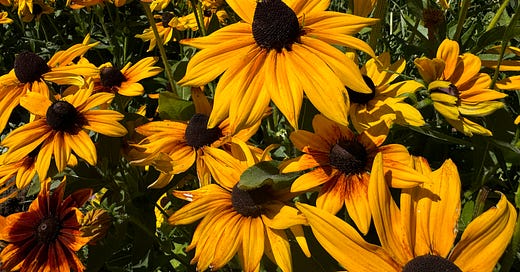Going for a walk in Calgary’s inner-city neighbourhoods means being constantly delighted by the presence of murals that, around each corner, surprise passersby and brighten up otherwise dingy nooks, driveways, or alleys.
Not too far from my doorstep sits a wooden fencing structure whose public-facing side boasts a colourful mural depicting a bee pollinating a field of chives, painted by the talented Sarah Johnson. Down the street, Leya Russell emblazoned the cedar planks of another enclosure with illustrations of trout and the Bow River that stand out against a bright teal background.
Despite the vibrancy of these murals, neither of them reflect life at the Sunnyhill co-op, where they are located, and where i live.
Because our material conditions at the co-op are vastly different from those of our neighbours, who started brightening Sunnyside’s alleys with garage-door murals after the 2013 flood, I have a hunch that the reason our murals don’t acknowledge who we are is that we strive to show that, despite our lower incomes, we fit into Sunnyside’s increasingly bourgeois milieu.
For many decades, Sunnyside remained a working class neighbourhood, but as gentrification started to push its way through in the ‘90s, residents have been displaced and replaced by a more affluent demographic.
No mural, however, speaks to this situation — why?
Let me introduce you to artwashing.
artwashing adj. the use of art and artists in a positive way to distract from or legitimize negative actions by an individual, organization, country, or government — especially in reference to gentrification.
The recent proliferation of murals isn’t unique to Calgary.
Mural festivals have been driving the revitalization of otherwise blank, dull walls in cities across Canada for at least a decade.
What makes Calgary different is that public art enthusiasts in our city have been slow to call out artwashing, or the use of art as a marketing tool to advance the interests of capital at the expense of people.
As essential signifiers of the creative class for the creative class, these festivals produce murals whose most salient feature is a lack of depth, of an authentic sense of place, regardless of their artistic merit.
What upwardly mobile professional would want to be confronted with issues such as displacement, poverty, or mental health, when they can surround themselves with instagrammable, eye-catching imagery of flowers, birds, bees, fantastic creatures, and abstract graphics?
Attending to social issues in the creative city has a time and place: not now and not here.
But while artwashing has become part of the discourse in cities like Vancouver and Toronto, in Calgary’s progressive circles, criticism to inherently good things such as urban art festivals is seldom welcome.
Here, conversations about public art have tended to focus on cost. Nearly 12 years after Travelling Light was unveiled, Calgary’s Giant Blue Ring still rouses the ire of many Calgarians for the large expense ($470,000) incurred by taxpayers.
This seems to leave no room for nuanced discussion, as Calgarians have no alternative but to be supportive of any and all types of public art — or none at all.
Across the city, murals have transformed formerly expressionless walls into points of interest that make our communities more vibrant, while obscuring the dismal reality of many Calgarians. Ironically, one of the values stated by Calgary’s mural festival, BUMP, is fostering community connection — but whose community? and, more importantly, on whose terms?
Many of Calgary’s murals are little more than monumental book covers; a life-size ornament disconnected from what it means to live in the Beltline, East Village — or Sunnyside.
In my neighbourhood, murals began as a grassroots, yet bourgeois, initiative.
One of the few traces of displacement is the disappearance of the murals themselves, as older dwellings (and their murals) are torn down to give way to luxury apartments, or just larger houses.
Meanwhile, in East Village, ever few years CMLC commissions an artist to brighten the columns that support the 5th Street flyover. In the current installation, Cassie Suche uses outsized fingerprints of community members to revitalize the area and, according to the artist’s statement, “speak to our individuality within a community, and our tactile connection to others and to our surroundings.”
I wonder how often East Village residents are invited by this mural to think about the tactile connection between their tent and the sidewalk, or between their bodies and the police; their presence here as ephemeral as the murals themselves.
In 2014, the unhoused community spearheaded a mural of their own, only to be painted over with flowers and birds five years later.
(I couldn’t find the exact date for when the original mural was replaced, but the last time it appears on Goggle street view is 2019.)
Perhaps the purpose of our city’s murals is to stand in contrast with the material conditions of the Calgarians we would prefer not to acknowledge; maybe by acting as mere ornaments, murals are meant to highlight the tensions between the displaced and the gentrifiers; between the haves and have-nots.
But for this to be true, we should be talking about it — so why don’t we?
Reluctantly yours,
Ximena
Stuff i’ve written recently
When tourism dreams depend on unjust employment
The Tyee
A home for those priced out of Calgary’s market
The Globe and Mail










